
|   |

|   |
Krishna Leelarnava: An endeavour worth emulation - Padma Murali e-mail: padmamurali@yahoo.com June 15, 2016 June 4 saw the celebration of the 10th anniversary of the Kalaarnava festival, curated by eminent flautist H.S. Venugopal. Part of the celebration was a magnum opus production ‘Krishna Leelarnava.’ Touted to be a rather unique production, it drew crowds from far and near, most braving torrential rains to reach the Dayananda Sagar College Auditorium located in the southern part of Bangalore. 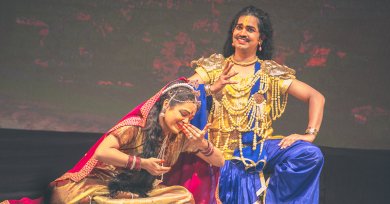 Close to 170 dancers and over 50 musicians and technicians were part of the making and staging of ‘Krishna Leelarnava,’ which had a more than full house audience glued to their seats for almost 4 hours to watch the life of Krishna from birth to Bhagavatham. Conceptualised by Venugopal with music composed and arranged by D.S. Srivastsa, Praveen D Rao and Varijashree Venugopal, Guru B. Bhanumathi had been handed the responsibility of artistic direction. Several other gurus and choreographers had also been roped in: Revathi Narasimhan, Poornima Gururaja, Kiran Subramanyam (Bharatanatyam), Nirupama and Rajendra (Kathak), Gopika Varma (Mohiniattam), Dharani Kashyap (Kuchipudi) and Sarita Mishra (Odissi), bringing together 5 classical dance styles in a neat sequence of scenes. The production opened with a pushpanjali choreographed by Bhanumathi and Sheela Chandrasekhar. Bringing together some of the rising star soloists of Bangalore, the perfectly synchronised pushpanjali set the pace for what was to follow. Delineating scenes of the grand marriage of Devaki and Vasudeva and their imprisonment thereafter, the depiction of the birth of Krishna by students of Bhanumathi was subtle. 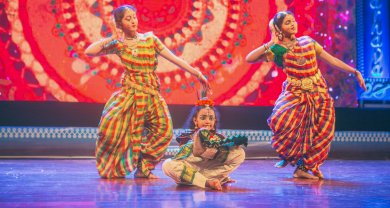 Krishna in Gokula (Poornima Gururaja) 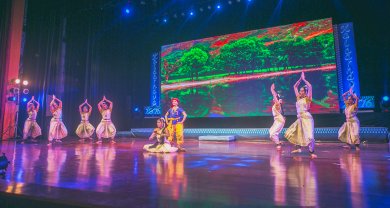 Kalinga Nartanam (Kiran Subramanyam)  Sarita Mishra 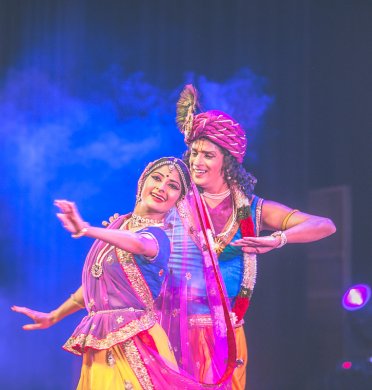 Nirupama and Rajendra Poornima Gururaja’s choreography of the samharam of Puthana and Sakatasura had some enthusiastic children adding vibrant colour. Kiran Subramanyam brought a fresh perspective with his choreography of the oft presented Kalinga Nartanam, combining fluid formations and intricate footwork with a sense of light hearted play that Krishna and his friends engage in. Aparna Shastry as a nimble yet menacing Kalinga who then is subdued at the feet of Krishna and Preeti Prasad as Krishna formed an impressive pair. Sarita Mishra followed with a solo rendition of the popular ashtapadi “Pashyati dishi dishi.” Her presentation was marked with apt abhinaya. Just as the audience settled in with Sarita's soft movements, Nirupama and Rajendra’s ensemble made one sit up with their vibrant Raas. The subtle inflections that Nirupama and Rajendra bring to the stage are a mark of their skill and experience. As a charming Radha and Krishna, they had the audience completely absorbed. The scene shifts to Krishna and Balarama as they begin their journey to Kamsa’s Dhanuryaga. Subtleties of the Gopis stopping Krishna from leaving and their dejection when he leaves were appropriately presented. Somasekhar as Balarama had a brief yet charming presence on stage while Jothi Raghavan as the deformed Kubja presented a well choreographed act. The Tandava Ensemble impressed with their portrayal of the demon warriors, who meet their end at the hands of the brothers. One must make special mention of the voice overs and percussion arrangements that lifted the scene hugely. Dharani Kashyap and her disciples followed with a depiction of Krishna, Rukmini and Satyabhama. Combining verses of the Bhagavatham and Narayana Theertha’s compositions, they told the story of the Parijata flower - cause for anguish for Satyabhama. As the lively Kuchipudi drew to a close, one was transported to an emotional high by Gopika Varma as Kuchela. Scenes of Kuchela reminiscing about his childhood with Krishna and his meeting Krishna at the palace gates drew up to an emotional crescendo.  Kubja (Jothi Raghavan) 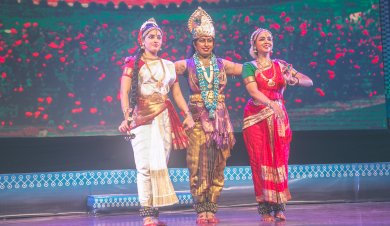 Rukmini and Satyabhama (Dharani Kashyap) 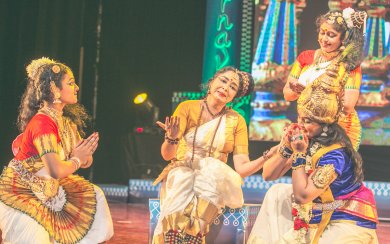 Kuchela (Gopika Varma) 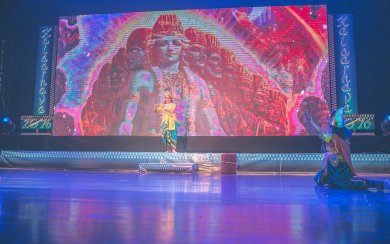 Vishwaroopam (B Bhanumathi-Sheela Chandrasekhar) Krishna’s sakhyam was further elaborated in episodes of Draupadi who by virtue of her selfless concern for Krishna, becomes his adopted sister. Samyuktha as Shakuni stole the show at the game of dice in Duryodhana’s court (choreographed by Revathi Narasimhan). The concluding segment pleasantly surprised all as Bhanumathi ascended the stage as Krishna, the charioteer for Arjuna (played by Sheela Chandrasekhar). The LED projections that had accompanied and presented an apt backdrop to every scene until now became the highlight of the concluding scene. In many other projects, one notices that projections either fall short of being complementary or interfere with the dance on stage. Kudos to Vinod Gowda and Sattvik Chakravarthy - the artists behind Krishna Leelarnava's projections that were intricate in detail and yet presented a simplistic backdrop sans any unnecessary frills. A thillana by a few senior dancers was a befitting finale. Could the production have been shorter by an hour or perhaps split over 2 days? Apprehensions exist but one must acknowledge that Krishna Leelarnava is a landmark production. Landmark, not because of the grandeur of scale, but because it showcased the genuine camaraderie that exists amongst the artistes - senior or upcoming, guru or student, musician or dancer. It showcased the commitment of over 200 people who have over the past few months dedicated several hours to collaborate with each other, in some cases with artistes whom they had never worked with before - an effort worth emulating across cities and artiste communities. Credits are due to the musicians, composers, sound engineers and technical arrangement team who have an equally primary role in the success of this venture. Padma Murali is the Founder -Director of Padmalaya Dance Foundation, Bangalore and the Chairperson of the International Dance Alliance (IDA) Bangalore Chapter. |